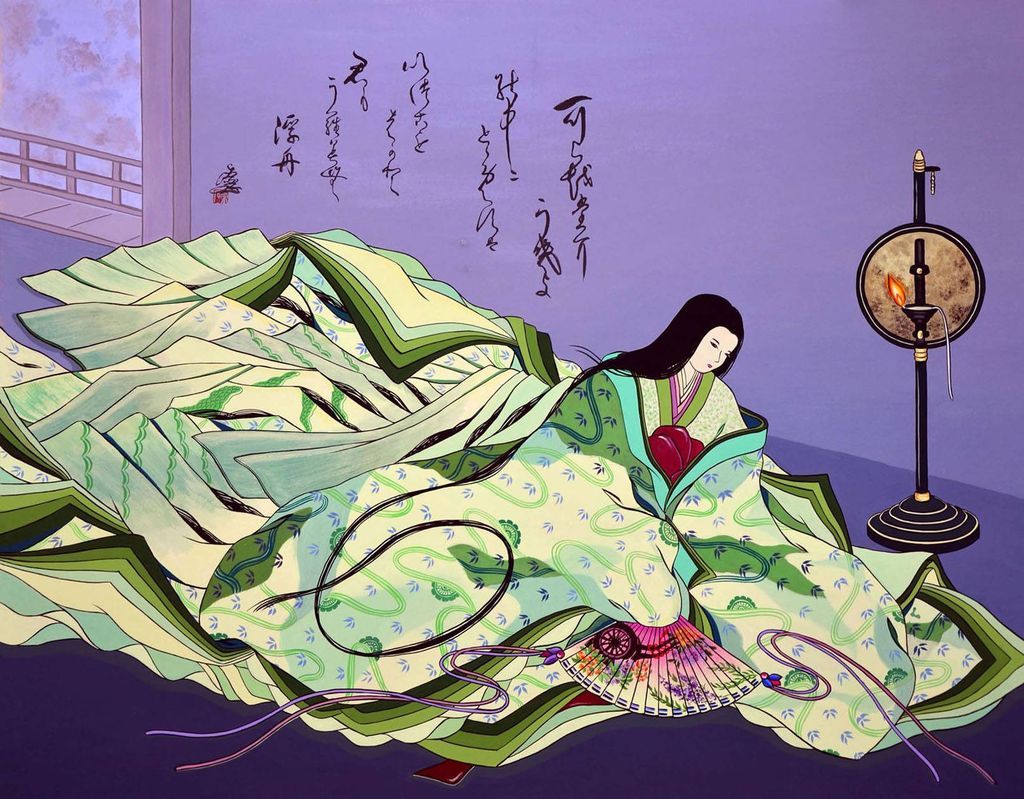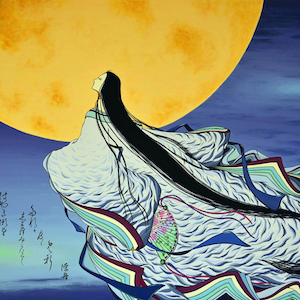
Cool Bookish Things: Agameishi’s Illustrations of THE TALE OF GENJI
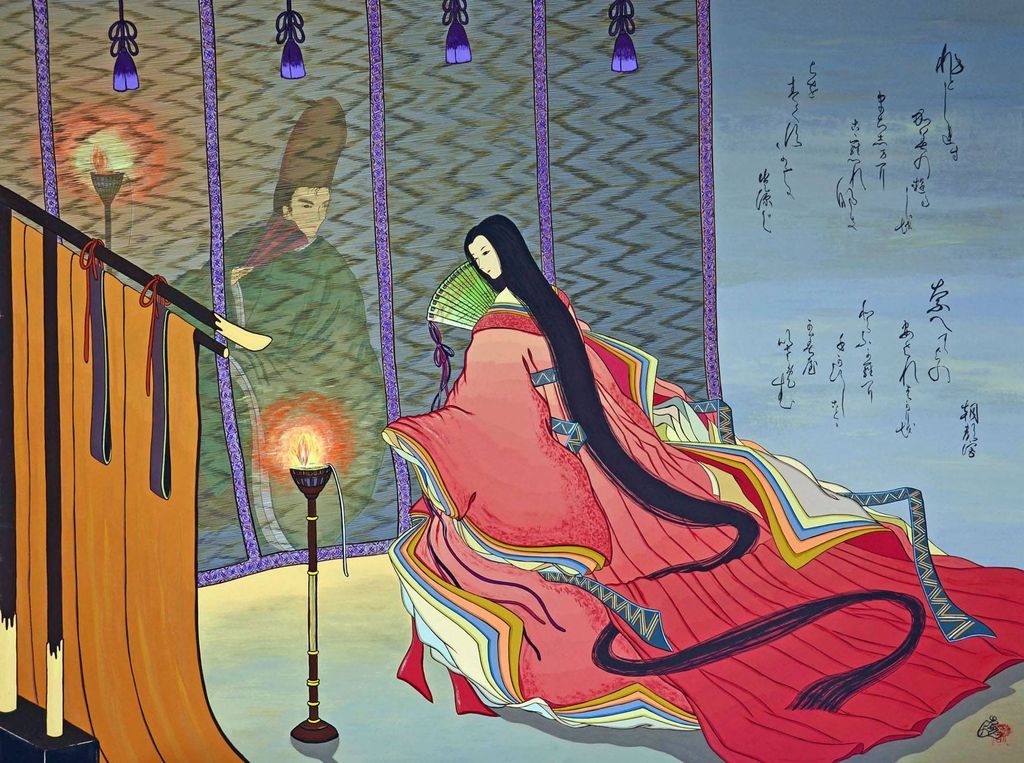
By the Purifying Wind, 600 Scenes of Genji, Scene 234, 1997
Acrylic & Gouache on Paper over Wood
35.5″ x 47″ x 0.5″
The Tale of Genji is no stranger to visual interpretation–it’s considered the longest and oldest illustrated scroll in the world. But no matter if you’re familiar with Genji or just like laying your eyeballs on some amazing and gorgeous images, the illustrations of Agameishi are like nothing you’ve ever seen before. By combining ancient painting and calligraphy styles with a modern use of perspective and a graphic design sensibility, Agameishi makes The Tale of Genji feel as current as the latest manga craze.
Most people are familiar with the Japanese art form Ukiyo-e, a painting style that originated in the Edo period (17th through the 19th centuries) as an expression of the common people. Likewise, most know what a Haiku is: a short poem of 17 syllables arranged in a 5-7-5 meter. Like Ukiyo-e, Haiku originated in the Edo period and was used by the average citizen.
Part of what makes Agameishi’s paintings so unique is that she DOESN’T look to these familiar art forms in her work. Instead, she paints in the much more ancient style of Kasen-e, used by nobility during the Heian period (late 8th century through late 12th).
Kasen-e combines painting, poetry, and calligraphy into a single unified image. In fact, Kasen-e is very similar to modern manga in the way it uses pictures and text to tell a story. Its overriding focus is on conveying the emotions of the characters portrayed: love, hate, longing, fear, sadness. The poetry that accompanies Kasen-e is called Waka, which has 31 syllables in a 5-7-5-7-7 meter. This is the poetry that makes up The Tale of Genji.
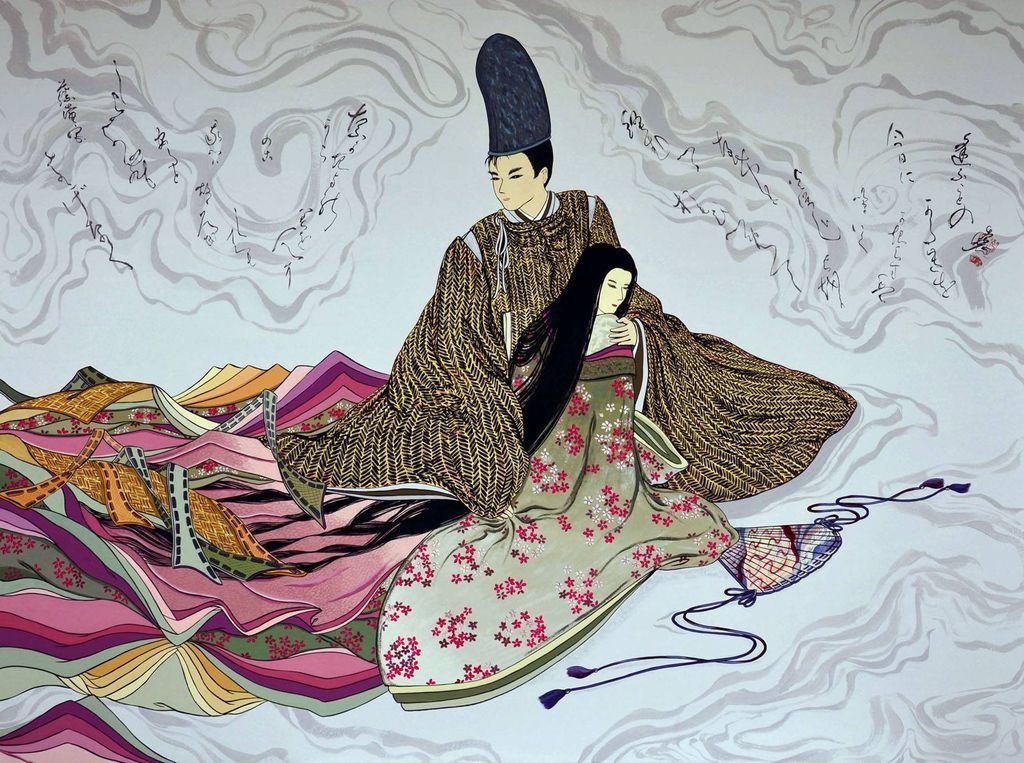
Fate and Illusion, 600 Scenes of Genji, Scene 114, 1994
Acrylic & Gouache on Paper over Wood
35.5″ x 47″
A trained calligrapher, Agameishi also favors an unusual style of Japanese writing called Kana. In the early history of Japan, writing styles were dictated by gender: men wrote in Kanji, an adaptation of Chinese ideographs. Kana, on the other hand, was uniquely Japanese and used only by women. The characters are phonetic, not ideographic, and Agameishi describes the calligraphic style of Kana beautifully: “It flows like a stream of water, a fascinating cascading line that feels as if it were alive.” This is the style of writing the author of Genji, Murasaki Shikibu, employed over 1000 years ago.
The process of creating each scene in the The Tale of Genji was time-consuming and laborious. Agameishi usually took up to two weeks to paint each illustration, using her calligraphy brush, which added touching sensitivity to every line. There was an important link between calligraphy and her visual work:
My style not only contains the calligraphic rendering of ancient Japanese (Waka) short poems, the entire picture is set in the way calligraphers endeavor to put written characters to life–and harmony–on paper… In my paintings, calligraphy characters combine like persons and the person characters appear like calligraphy.
Then came the crucial moment: the writing of the poem. While painting the illustration may have taken weeks, Agameishi completed the poems in a minute or less.
It is an incredibly intense moment… Not only due to the fact that the painting would be lost if my calligraphy turned out poor or contained a mistake. It is also the culmination of my relationship with the subject matter.
The intensity of that final act of completing the work is infused into every scene Agameishi creates.
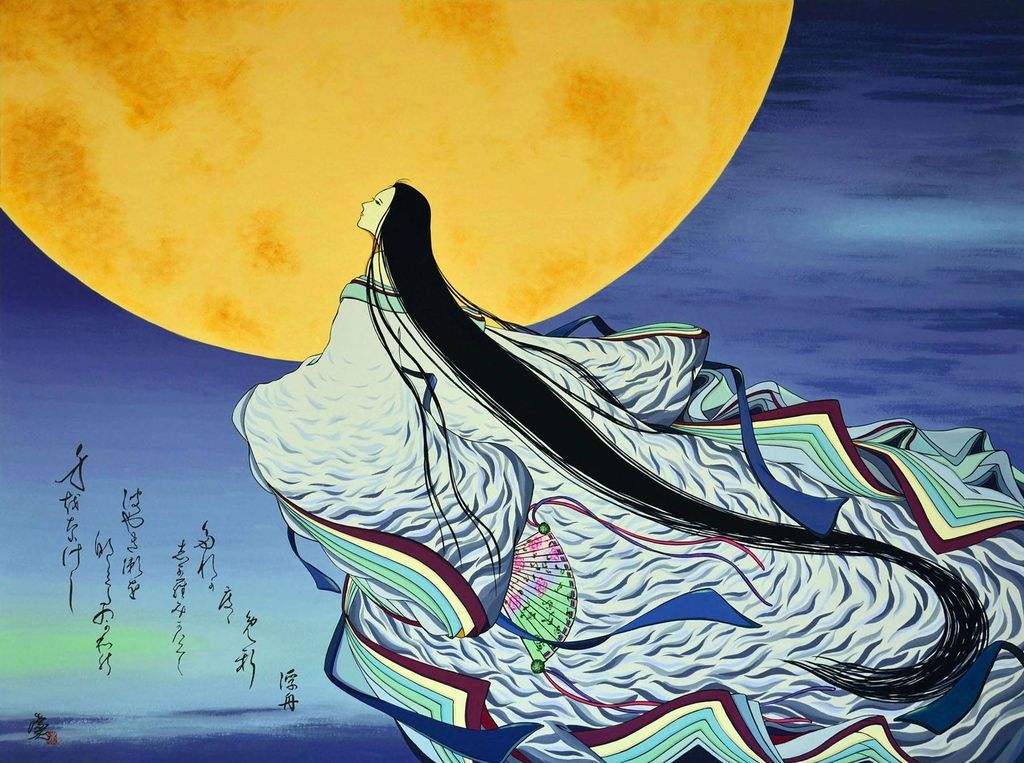
Known to the Moon Alone, 600 Scenes of Genji, Scene 578, 2008
Acrylic & Gouache on Paper over Wood
35.5″ x 47″ x 0.5″
Not only does she use historically accurate illustration and calligraphic techniques, Agameishi also extensively researched the architecture, clothing, and material culture of the early 11th century Japanese nobility so that every scene would be authentic to the Heian period. The flowing robes of the female characters, for example, look completely fantastical in a beautiful, artistically expressive way. But in fact they’re an ancient style of court dress called Ju-Ni-Hitoe, or 12-layer robes. A former dressmaker, Agameishi sewed her own 12-layer robe out of a kimono and sheets and modeled it in a mirror for use in her illustrations.
Agameishi set out to illustrate every Waka poem in The Tale of Genji–that’s 795 scenes–in 1986, and only completed it in 2008, more than thirty years later. She’s crazy dedicated to her craft, even going so far as to teach herself to use her left hand for everything but calligraphy after her right hand started going numb from overwork.
But the real question is why–why dedicate so much time and personal energy to comprehensively illustrating this massive novel? First of all, Agameishi loves the book:
It is about society, about obligations, about political order, about ambitions, about power and about love. But although the story describes how people of at the apex of society struggle together or against one another, there is no violence, no word about military campaigns, no glorification of cruelty, no conquests. It is… a model for the attitude [of] Japan (or any country)… to be eager to learn from others and to blend foreign arts with its own culture and diversity.
In this setting of peace, the focus is on individuals’ relationship to one another. This is how each person’s sentiments appear clearly, without being blurred by an overarching dramatic plot. So although The Tale of Genji was written 1000 years ago, it continues to be an incredibly modern novel.
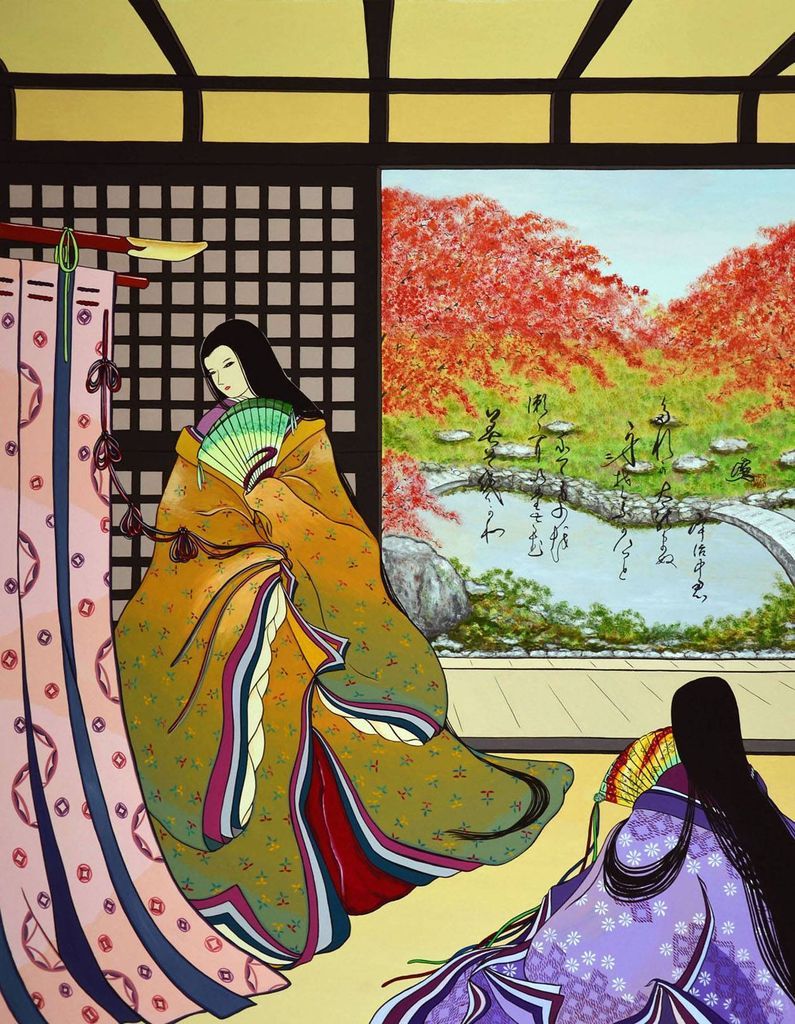
Let Us Just Be Friends (Ⅱ), 600 Scenes of Genji, Scene 543, 2006
Acrylic & Gouache on Paper over Wood
35.5″ x 27.5″
Yet what most people don’t know is that the Kana writing in The Tale of Genji is nearly incomprehensible to all but a very few people in Japan. Modern translations contain anachronisms, annotations, and lose some of the meaning of the original manuscript. Although the Kana in Agameishi’s paintings is not necessarily any more comprehensible–especially to people who don’t read Japanese–her illustrations speak more loudly than words. By turning the perspective of the scenes into a more traditional Western view and using bright, graphic colors, Agameishi puts the viewer into the middle of a modern scene that feels cinematic. In fact, she describes the Waka poems as, “…like as many scenic or close-up views in a movie. Each depicts a key moment.” Her focus on the emotional content of every scene makes the 1,000-plus year-old characters of this complex tome feel a close to us any character in a contemporary novel.
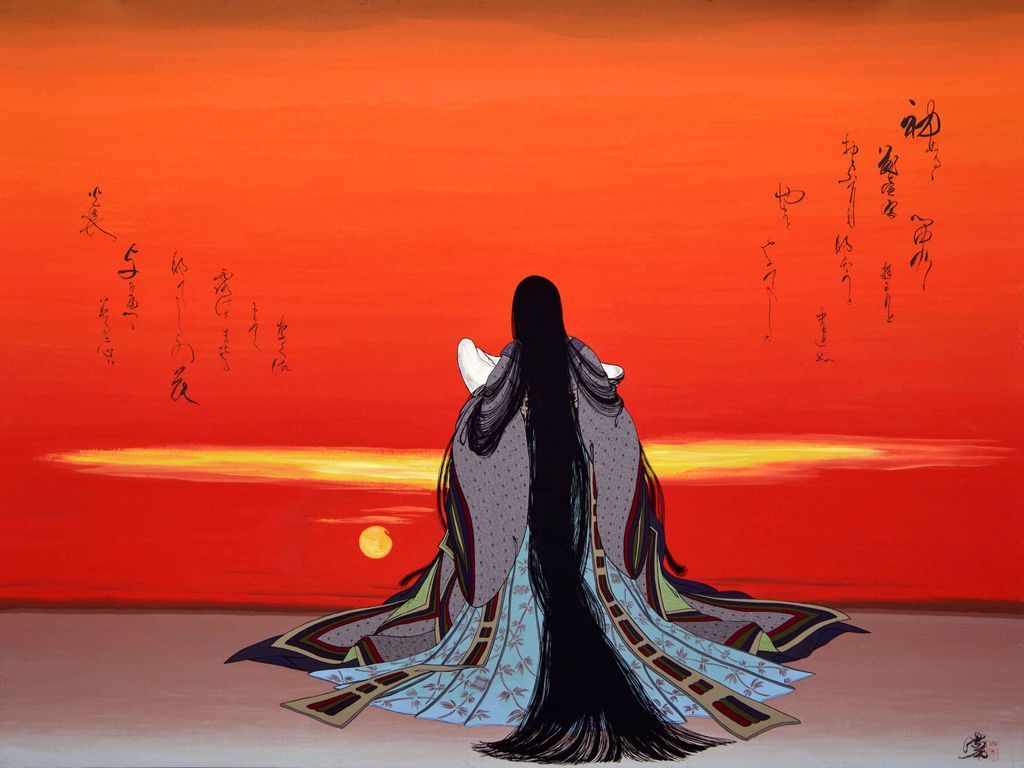
Evening Glow, 600 Scenes of Genji, Scene 68, 1993
Acrylic & Gouache on Paper over Wood
35.5″ x 47″ x 0.5″
All images used with permission from Agora Gallery. Check out Agameishi’s Art-Mine page or website for more information!
____________________
Follow us on Pinterest for drool-worthy covers, Book Fetish-y lit swag, bookish inspiration, and more!


